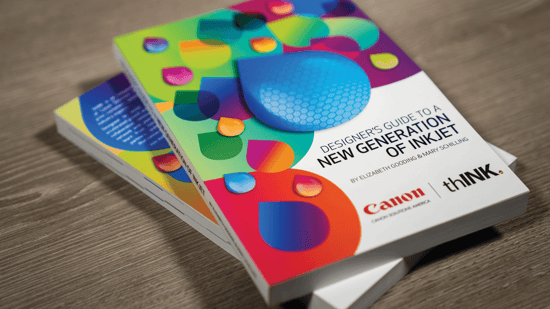Designing for Inkjet: Which Image File Format is Best?

JPEG, TIF, EPS — when designing for inkjet, does the image file type you use matter? And what’s the difference between these file types anyway? Actually, it does matter which file type you choose. The difference between these common image file types is in the way they compress bitmap data — and how well they retain the color data in the saved file. Some methods of compression sacrifice image quality, which may not matter as much for digital applications but could be quite noticeable if you’re going to print.
The Best Image File Types for Print, Ranked
1. JPEG (Joint Photographic Expert Group, aka .jpg)
This is a common file format for workflows that have to process a large amount of color images at a high rate of speed. JPEGs use adjustable compression (low, medium, high, and maximum), sometimes called “lossy,” which allows a selectable trade-off between storage size and image quality.
Continuous tone photo images stored as JPEGs are very small and efficient, but JPEGs do not work well for solid image graphics such as logos.
JPEGs are best suited for variable or static bitmap images. When working with JPEGs, choose a “low” or “medium” quality setting if you are working with small files and are not as concerned with image quality. Choose a “high” or “maximum” quality setting for files that need to be small in size but high in quality.
For all JPEG images, do not repeatedly edit and save, as artifacts are added each time and quality is lost. We repeat: every time you save a JPEG file, quality is reduced! Complete your edits using a lossless file format (see below) and then save as a JPEG when the image is final. If further edits are required, use the original file and create a new JPEG.
One note: If you are planning to assign PMS colors to your bitmap and/or vector images, and your print provider’s workflow supports it, do not use JPEG, as it does not retain the PMS data and automatically converts to CMYK or RGB.
2. TIFF (Tagged Image File Format, aka .tif or .tiff)
TIFF image files use “lossless” compression, which is considered the highest quality format for print work. This doesn’t mean that TIFFs are “higher quality” images in and of themselves; it simply means that, upon compression, there is no loss of color data or added artifacts that degrade the image file (like with JPEGs). TIFFs are larger than JPEG files and work with both RGB and CMYK bitmap and vector images.
3. Vector EPS (Encapsulated Postscript, aka .eps)
Created by Adobe back in 1992, EPS is the format for most graphic design elements that are created and exported for Adobe Illustrator or InDesign and shared across all Adobe programs. Many designers work with EPS files until they are ready to save final files in the format best suited to the production workflow.
Use EPS files for static solids and logos. This file type will give you the smoothest colors.
Always Check with Your Print Provider
One More Thing!
When saving an Adobe® Photoshop® file, make sure to save the working profile color space of your design. This color data will stay attached to the file all the way through the print provider’s workflow, targeting that color space. This provides the assigned rendering intent a more accurate conversion path from one color space to another.
These inkjet design best practices are adapted from our go-to resource, The Designer’s Guide for Inkjet. Want more? Download your own copy of The Designer’s Guide to Inkjet, 3rd Edition.
See More Like This
See MoreMarketing Collateral
Project Spotlight: A Practical Giveaway to Keep thINK Ahead Attendees Cool
Marketing Collateral
Project Spotlight: A Blank Canvas for Organization and Inspiration
Marketing Collateral
Project Spotlight: Exploring the Wide World of Color
Marketing Collateral
Project Spotlight: A Planner and Journal for Exploration and Discovery